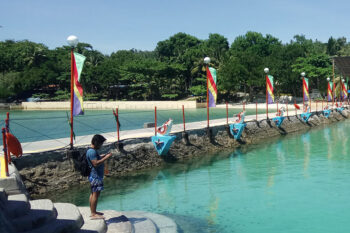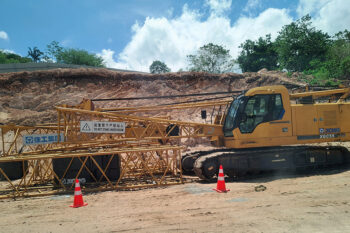NAAWAN, Misamis Oriental (MindaNews/10 October) — The month of October every year is celebrated across the country as Indigenous Peoples Month. This celebration, by virtue of Proclamation 1906, s.2009, is intended to bring to the national consciousness awareness and understanding of the life, struggle and plight of the indigenous peoples (IPs) in the country. The mainstream Christian churches across the country also celebrate the second Sunday of October every year as Indigenous Peoples Sunday as an expression of their solidarity with this marginalized sector of our society.
The IPs, which constitute from 10 -15 percent of the Philippine population, may be differentiated from the rest of the population by their distinct language, ancestor and animistic belief, culture, tradition and practices. They are also observed to have very strong attachment to their ancestral land, territory and resources for survival and sustenance.
The indigenous peoples are settled in forests, mountains, along lakes and river systems, in lowlands and also in some coastal areas. They are the most neglected and discriminated upon in the provision of social services by the government. The communities of IPs who have retreated into the hinterlands are the poorest in the class. They are not linked to road network and therefore live in isolation. They have no access to power and water system and are deprived of the benefits of schools, health services and other social amenities that are available in the lowland.
Mindanao has the highest concentration of IPs (18 out of 40) throughout the country yet reportedly gets the smallest budgetary allocations from the national government. The indigenous peoples in Mindanao, better known as Lumad, experience now and then hunger and starvation due to seasonal or chronic food shortages. This phenomenon is brought upon them by the scourge of climate change, armed conflict, increasing devastation and degradation of the environment, and loss of ancestral land to extractive industries like mining and logging which reduce harvests or destroy crops.
The passage of R.A. 8371, otherwise known as the Indigenous Peoples Act (IPRA) of 1997 is a government attempt to secure and protect the rights and interest of the indigenous peoples and correct the injustice they have suffered through the years.
Among the IPs, not one may top the Badjao, the sea gypsies who in the past roamed the Sulu seas, as the people who have suffered so much from the neglect and indifference of the government and their rejection by society. Their unfortunate circumstances scattered them throughout the land where their host communities treat them with absolute disdain. They have been perceived as lazy and unreliable and as incorrigible tramps and thieves.
Of ocean origin and now dispersed everywhere, the Badjao have hardly any claim to the rights, protection and current attention given to land-based indigenous peoples under the Indigenous Peoples Rights Act.
Who are the Badjao? What actually caused their Diaspora and their being shunned by everyone as eyesore in society?
The Badjao were once a self-reliant and free people of the Sulu seas who were primarily dependent on the bounty of the seas to survive. In recent times, however, they experienced deprivation, poverty and hunger resulting from the destruction and continuous degradation of their marine environment. This came about with the incursion of commercial fishers into their traditional fishing grounds and by the gypsies’ adoption of destructive and unsustainable fishing activities. Many were forced to leave their communities not only to escape poverty but also their exploitation by land-based tribes and the harassment they had been subjected to by pirates.
The Badjao are the ocean-based counterpart of the nomadic Mamanwa in the forests of Surigao and Agusan provinces. The Badjao used to live in boathouses that clustered near an island of choice in any particular moment.
A community of Badjao would consist of 15 to as many as 50 boathouses. They spent most of their times in the sea, fishing, gathering seashells or pearls in the wild. They would only set foot on dry land to sell their products, to buy pangi or pyoto – a grated unsweetened cassava cake, to fetch drinking water, to gather firewood, and to bury their dead. The Badjao used to practice sustainable fishing with hook and line, spear and traps, getting only what they needed for the day, or what to barter with the islanders for land-based food sources.
The Badjao were humble and peace-loving people. They avoided conflict of any kind. If provoked by land people, they would just bow their head and move away from their tormentors. They would never fight back even if they were right. When threatened, they would simply pull their anchors and sail to another place.
Their Sama and Tausog neighbors in the islands gave the Badjao derogatory names, such as Samal laos (outcast Samal) or lumaan (God-forsaken people). The Badjao used to settle along the shores of some islands in the Sulu archipelago, but many eventually retreated to the sea to end their rejection and oppression by the islanders.
Conflict among neighbors in the Badjao community was, accordingly, resolved in an impromptu-like “singing” contest within the hearing distance of everybody. The conflicting parties would outpour in a singing-like manner their grievances, resentment and sentiments one after the other until everything in their heart had been aired out. After the outpouring marathon things would accordingly return to normal.
The Badjao practiced ancestor worship and monogamy. It was one boat one wife one family. For them sex was a natural biological phenomenon. Accordingly in the past, when a husband felt like doing it with his mate he would do it all inside the boat, the children might be playing around, or even within the viewing distance of their neighbors. There was no need to wait for the night to fall, for the kids to go to sleep, for the neighborhood to become still, because everybody knew anyway anytime they would do it as their boathouses were interconnected in a temporary settlement. The Badjao had no concept of privacy, or an idea of malice, given that almost everything in life was done in an open boat in the open sea.
Some Muslim and Christian missionaries tried to change their way of life but were generally unsuccessful. Certainly, they had captured some few unfortunate souls and taught them the concepts of malice and sin. But the rest of the Badjao have remained free from the tyranny of organized beliefs.
Things changed tragically, however, when Martial Law was declared in the country. To counter the MNLF uprising, the Armed Forces of the Philippines stationed military units in almost every island in the Sulu Archipelago. Some rogue military men befriended the Badjao and taught them how to improve their daily fish catch through dynamite fishing.
The new fishing method altered the perspective and the sustainable life of the sea gypsies. They experienced a sudden boom in their fishing activity, so radical the change that they didn’t even know what to do entirely with their excessive harvest or their extra money. They still lived in their boathouses and they had not much need for anything. Of course, some of the men now stayed longer in dry land with their new found friends and learned to booze.
It was not too long, however, when most of the traditional fishing grounds of the gypsies were destroyed and soon became unproductive. Life started to become a daily ordeal to the once self-sufficient people.
Then some NGOs and government agencies came to the rescue. They taught the Badjao how to operate and maintain a seaweed farm. This became another boom in their economic life. The men in the boathouses would again tarry in dry land after harvest time, eating, drinking and spending their dough in pubs and local entertainment houses. But the economic rise of the boat people ended dramatically when pirates forcibly divested them of their income every harvest time. The Badjao had to scamper to safety. There was no option but to move away from the Sulu seas.
So began the Diaspora and exodus of the Badjao away from home. They hovered for some time in Zamboanga City, and without employable skills they were reduced to begging just to survive. Zamboanga City very soon became too crowded for them, thus many ventured farther away into the different cities of Mindanao, in the Visayas and, finally, in MetroManila.
In Manila, they have survived primarily from begging and over time, when they had learned the local language, by peddling, driving tricycles and doing odd jobs for those who have shown them little kindness. With very limited income, they are forced to live and sleep in the streets, under flyovers, or in makeshift shelters along the seawalls of Roxas Boulevard near Baclaran.
Their dwellings were destroyed now and then, and the owners arrested and advised to go back to where they came from. In many occasions, the boat people were herded by authorities in Metro Manila and returned to Zamboanga City. But after saving for some fare money, they would make a comeback to the metropolis, now improving and honing the art of begging and whatever acquired skills they have to survive.
The boat people from the Sulu seas are now scattered everywhere. In a generation or two, they would completely forget their origin, their history, culture and traditions. Except those who practice begging in seaports, many Badjao very soon may even forget how to swim, when not long ago they were already swimming even before they started walking. The government and everyone want them to go home. Under the present circumstances, however, going home to the place and time where and when they were free from the burdens and demands of our own civilization is increasingly becoming impossible. (William R. Adan, Ph.D., was a research and extension worker, professor and the first chancellor of the Mindanao State University at Naawan, Misamis Oriental. He was a British Council fellow and trained in 1994 at Sheffield University, United Kingdom, on Participatory Planning and Environmentally Responsible Development. Upon retirement, he served as national consultant to the ADB-DENR project on integrated coastal resource management. He is the immediate past president of the MSU Alumni Association.)







